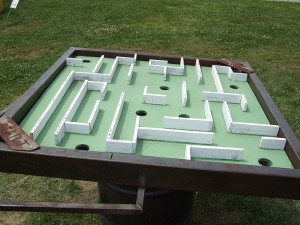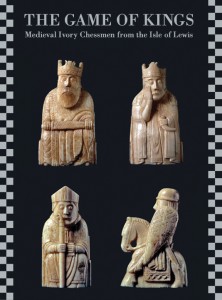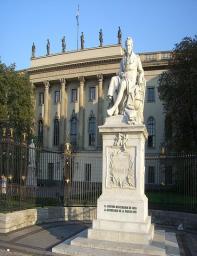August 10, 2015 in Art | Comments (0)
Tags: Brooklyn Bridge Park, Governor's Island, Metropolitan Museum of Art, Outdoor Art

“Labyrinth of Failure” by Kim Navarre from Brooklyn, NY – Labyrinth of Failure by Chris Hackett and Eleanor LovinskyUploaded by McGeddon. Licensed under CC BY-SA 2.0 via Commons
Seeing art outdoors is a wonderful experience. When the installation becomes a part of the environment, something is added which is impossible to replicate within the four walls of a building, no matter how innovative that building might be.
Check out some, or all, of these delightful, creative, even wondrous works of art, proudly exhibited in the great outdoors of New York City.
• Here’s a great excuse to go visit Governor’s Island– The Interactive Sculpture Garden at the parade grounds. This delightful playland contains a real, working tree house, lots of shade, and even an artistic mini-golf course. And you get a trip on the ferry, too.
• On the roof of the Metropolitan Museum of Art visitors will encounter a huge fish tank containing an eye-popping lava rock which beckons to the various lampreys and tadpole shrimp swimming inside. There is also a rather large boulder of the thing that made Manhattan great; Manhattan schist- the material New York’s skyscrapers, which can be seen in the distance, are made.
• At Brooklyn Bridge Park, until April 17, 2016, three installations incorporate the view of Manhattan’s skyline into the works. One is a group of mirrors, which literally “mirrors” the skyline seen in the distance; Bright red benches twist and turn in unlikely shapes, encouraging children to join in the fun; and a water sculpture brings welcome relief from the humid heat of a typical New York summer. Stroll through the fountain and notice that wherever you walk within, that is where the water stops gushing.
December 12, 2011 in Museums | Comments (0)
Tags: Fort Tryon Park, Lewis Chessmen, medieval Europe, Metropolitan Museum of Art, The Cloisters

A Bit of Medieval Europe in New York
In upper Manhattan there is a less well-known branch of New York’s Metropolitan Museum of Art, called The Cloisters. This fascinating building is dedicated to the art and architecture of medieval Europe, and the structure itself is an example of that, as it was assembled from both the domestic and religious elements that date back to the twelfth through fifteenth centuries.
The Cloisters and its surrounding gardens are located in Fort Tryon Park, in the northernmost end of Manhattan, overlooking the Hudson River on the west. A visit there is like visiting a medieval European monastery, but without the monks. In place of the monks you will find about three thousand artworks dating from as long ago as the ninth century, and no more recent than the sixteenth century.
The Cloisters is easy to get to by bus, car or subway, and from April through October the Trie Café offers light meals and snacks which are served outdoors in the French medieval Trie Cloister. If you visit now until April 22 you will be treated to a unique exhibit of what are most likely the most famous chess pieces in the world, the Lewis Chessmen. These carved ivory chessmen were discovered in 1831 on the Isle of

12th Century Lewis Chessmen
Lewis off the coast of Scotland, and date from the twelfth century. The chessmen rarely leave their home in the British Museum, but for this exhibit over thirty of the chessmen are on display, representing the largest assembly of these unique objects outside of the United Kingdom.
What helped to make these chessmen so famous is that replicas of them were used in the famous “Chess Game” scene in one of the Harry Potter movies, only enlarged to the size of people.
Check out The Cloisters and the Lewis Chessmen; It’s like a visit it Europe of the Middle Ages.
September 26, 2011 in Tourism | Comments (0)
Tags: American Museum of Natural History, Circle Line Cruise, Ellis Island, Empire State Building, Guggenheim Museum, Metropolitan Museum of Art, Museum of Modern Art, New York CityPASS, Statue of Liberty, Top of the Rock
Visitors to New York should know about a great way to save money and time when they visit some of New York’s most beloved attractions, CityPASS.
 For only $79 for an adult and $59 for a child, New York CityPASS allows holders to strut right past the lines for tickets to the following six destinations, at about half the price it would cost if the entrance fees were paid for at each site.
For only $79 for an adult and $59 for a child, New York CityPASS allows holders to strut right past the lines for tickets to the following six destinations, at about half the price it would cost if the entrance fees were paid for at each site.
• The Empire State Building
• The Metropolitan Museum of Art
• The American Museum of Natural History
• The Museum of Modern Art
• Either the Statue of Liberty and Ellis Island Tour or a Circle Line Cruise
• Either Top of the Rock or the Guggenheim Museum
The CityPASS is valid for nine days from the time the first attraction is visited. You receive with your tickets in-depth information about each site, including hours of operation, location, a map and tips.
Next time you are in New York, consider getting a CityPASS to ease your stay and make it the best visit to the Big Apple that you ever had.
May 9, 2011 in Art,Fashion,Museums | Comments (0)
Tags: Alexander McQueen, Andrew Bolton, Costume Institute, fashion design, Metropolitan Museum of Art
Pulling in visitors in numbers greater than any other Costume Institute Show in history, the New York Metropolitan Museum of Art had to suspend their guided tours because of overflow crowds.
Garnering an astounding 5,100 people to opening day last Wednesday, the new Alexander McQueen exhibit came close to the record set by the museum’s most busy opening day ever in its history: “Vincent van Gogh: The Drawings,” which brought in 5,400 people back in 2005.
Savage Beauty Showcases McQueen’s Contrasts

Alexander McQueen
Alexander McQueen, the world famous clothing designer, who died last year, was not afraid to explore the world of contrasts: Dark and light; past and future; masculine and feminine. Thus the name of the exhibit, “Savage Beauty,” the first such show since his passing, is certainly apropos.
The Met’s Costume Institute explores the fabulous world of McQueen extremes, an intellectual and an artist, whose career as a designer was celebrated until his suicide at the age of 40 in February of 2010. His was a journey into the world of contrasts, where he challenged the usual ideas about beauty, while going for the shocking statement whenever he felt it was appropriate.
McQueen Challenged Normal Notions of Beauty
The exhibit curator, Andrew Bolton said that McQueen was always exploring ways to question normal conventions of fashion and beauty, citing a quot e from Shakespeare which he had tattooed on his arm, which is also the starting point for the show: “Love looks not with the eyes, but with the mind.”
e from Shakespeare which he had tattooed on his arm, which is also the starting point for the show: “Love looks not with the eyes, but with the mind.”
These words were said by Helena from a Midsummer Night’s Dream, explained Bolton, who was someone who believed that love had the power to transform the ordinary into the beautiful.
 Designer was Also a Believer
Designer was Also a Believer
Bolton continued to explain that McQueen was not unlike Helena, for he, too was a believer:
“All of McQueen’s collections were fashioned around elaborate narratives, and the exhibition is intended to evoke a gothic fairy tale, a fairy tale that is pushed forward by McQueen’s imagination.”






